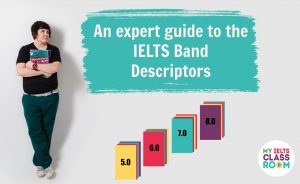
IELTS Examples: Where should you put them in a paragraph?
Hey! We all know that every IELTS essay needs at least ONE clear example to satisfy the band descriptors. But, where are you putting that example in your essay? Did you know that examples have to support the sentence DIRECTLY before them? If not, read on to save your Coherence and Cohesion score in your next essay!
Where is the wrong place for an IELTS example?
I always think it is better to show students a problem before I give them the solution. So, I would like you to read this paragraph from an essay that one of my new students sent me this week. Pay particular attention to the example. Tell me, does it look good to you?
On the other hand, I side with those who agree that second-languages should be taught as early as possible because it is easy to mould a child’s brain at a young age. This skill can be introduced in a fun learning and interactive way in class. For example, it is scientifically proven that children from the age of 3 to 10 have the capacity to learn more than one language at a time naturally without explicit instruction.
What do you think? Is that a good example? Well, I think in terms of information, this is an excellent example and could definitely be used as supporting detail. The problem is WHERE it is in the paragraph. You see, examples must always support the argument given in the SENTENCE DIRECTLY BEFORE THEM. In other words, they have to be an example of the information given in the previous sentence. But, what information were we given in the sentence before the example here?
This skill can be introduced in a fun learning and interactive way in class.
- Does this sentence have ANYTHING to do with the age at which children learn a language naturally? No!
- Does the example of children learning naturally between the ages of 3 and 10 tell me anything about “fun and interactive learning”? No!
- Is this a good example then? No!!!!
Even though the example is connected to the topic of the paragraph, it is a bad example because it does not support the sentence that comes directly before it !!!
So, what can we do to fix this? Well, we just need to move the example to a place in the paragraph where it follows a sentence that talks about the AGE that children learn a language.
On the other hand, I side with those who agree that second-languages should be taught as early as possible because it is easy to mould a child’s brain at a young age. For example, it is scientifically proven that children from the age of 3 to 10 have the capacity to learn more than one language at a time naturally without explicit instruction. Bilingual children are the best illustration of this, as they are able to learn two languages simply by hearing them in their home environment. Therefore, a second language can be introduced in a fun learning and interactive way in class.
Can you see how the paragraph “flows” much better now that the example is placed after the topic sentence? First I make the claim that it is better to learn at an early age and then I immediately support this argument with the example to justify it.
Also, note how I have added another sentence to support my argument further. I don’t believe it is ever enough to say “it is scientifically proven” to support an argument (I have another blog about this, which I really encourage you to read) . Adding the sentence about bilingual children is a great way of showing genuine support because it JUSTIFIES the claim i.e. it gives a genuine reason for the argument that children can learn naturally.
Want to know how the examiner will apply the band descriptors when marking your IELTS essay?
Then download a copy of our FREE e-book, which explains how each of the four marking criteria is applied and includes the most common errors made by test-takers. Just click here for your copy.

Make sure you extend every argument in an IELTS essay
Now we have moved the example to its correct position earlier in the paragraph, we are not left with a sentence that has NO EXTENSION:
Therefore, a second language can be introduced in a fun learning and interactive way in class.
If we don’t add support to this argument, our second idea will be only ONE sentence, which is never a good idea. Remember, to be able to give you a 7.0 for Task Response the examiner needs to see ideas that are extended and support your argument, so they HATE single-sentence arguments! Let’s add some more information then about how classes can be more interactive and fun if teachers don’t have to focus on explicit learning:
On the other hand, I side with those who agree that second-languages should be taught as early as possible because it is easy to mould a child’s brain at a young age. For example, it is scientifically proven that children from the age of 3 to 10 have the capacity to learn more than one language at a time naturally without explicit instruction. Bilingual children are the best illustration of this as they are able to learn two languages simply by hearing them in their home environment. In fact, schools can use a similar technique, introducing children to the new language using fun, interactive activities rather than structured grammar classes. Games and songs in the target language can be used in class, which will encourage the children to participate more and be more effective than learning in a traditional class later in their school-career.
Now, we have our example in the correct place AND a paragraph that is fully extended. It is win win! So, what’s the lesson today?
Don’t always automatically put your example at the end of the paragraph!
As we have just seen, sometimes the correct place is right at the beginning after the topic sentence! Just make sure that your example 100% supports the sentence directly before it and you will always put it in the correct place!
If you are just starting your IELTS journey, then the most important thing that you can do is learn what the IELTS band descriptors are and how the examiner uses them to mark your writing. Why not watch my FREE introduction video lesson to find out how you can use the band descriptors to maximise your score!!

